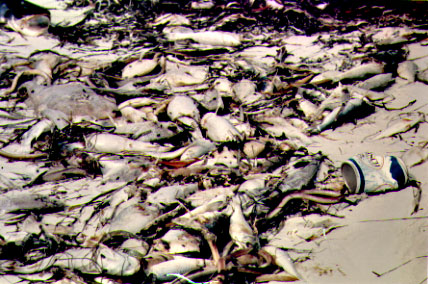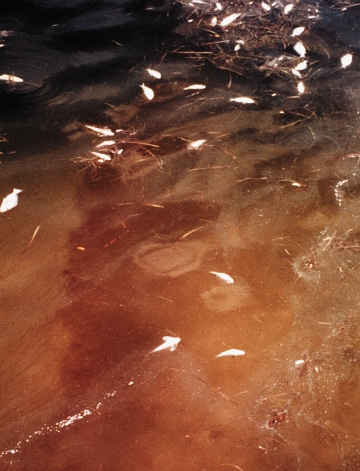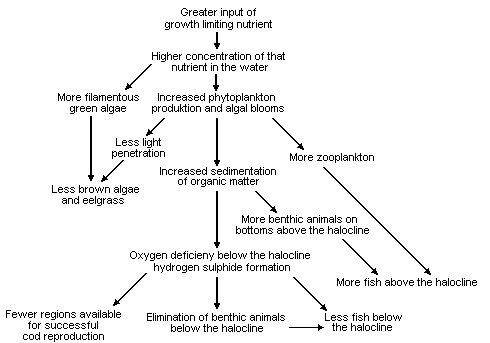EUTROPHICATION

by E. Carson Barrow
What are the effects of eutrophication?
What can be done to remediate eutrophication?
Eutrophication
is, in the simplest terms, too much of a good thing. It occurs when too
many nutrients are deposited into a body of water, throwing off the established
balance of production and consumption of organic matter. Eutrophication
can take place in ponds, lakes, rivers, and oceans. At first, the overload
of nutrients in the body of water encourages plant growth. However, soon
this excess of organic material uses up most of the available oxygen in
the water, taking it away from the other plants and animals. These other
organisms can no longer survive with such depleted oxygen levels and die
off, creating what is referred to sometimes as a "dead zone", devoid of
life.
Below
is a table of the different trophic states, or levels of organic matter
in relation to available oxygen, that a body of water traverses on its
way to becoming a "dead zone".
|
|
| Oligotrophic | Clear waters with little organic matter or sediment and minimum biological activity. |
| Mesotrophic | Waters with more nutrients, and therefore, more biological productivity. |
| Eutrophic | Waters extremely rich in nutrients, with high biological productivity. Some species may be choked out. |
| Hypereutrophic | Murky, highly productive waters, closest to the wetland status. Many clearwater species cannot survive. |
| Dystrophic | Low in nutrients, highly colored with dissolved humic organic material. (Not necessarily a part of the natural trophic progression.) |
Eutrophication of bodies of water is a naturally occurring phenomenon.
However, the process has been aggravated by the human population.  Such
man-made eutrophication is caused by excessive discharge of nutrients,
especially phosphorous (P) in the form PO4, nitrogen (N) in the form NO3,
and silicate. Pictured is a diagram of how nutrients, such as phosphorous,
in runoff lead to plant and animal die offs.
Such
man-made eutrophication is caused by excessive discharge of nutrients,
especially phosphorous (P) in the form PO4, nitrogen (N) in the form NO3,
and silicate. Pictured is a diagram of how nutrients, such as phosphorous,
in runoff lead to plant and animal die offs.
In
this diagram, phosphorous in the surface runoff fertilizes small floating
aquatic plants. As these aquatic plants proliferate, sunlight penetration
is reduced. Submerged aquatic vegetation can no longer survive, and as
they die and decompose, oxygen levels in the water are also depleted. Eventually,
animals die too, due to lack of oxygen.
Some
probable causes of this excessive nutrient runoff include sewage treatment
plant leakage, septic tank leakage, urban runoff, agricultural runoff,
channel dredging, and loss of wetlands.
As
mentioned earlier, the initial effect of eutrophication- increased productivity-
is deceptively good. However, the first indications of eutrophication's
ill effects are such visual changes as muddled and discolored water, coupled
with a noxious odor. This change in water  clarity
is a result of the primary effect of eutrophication, which is algal blooms.
To the left is an example of such an algal bloom. For more examples of
what algal blooms look like, click on the image.
clarity
is a result of the primary effect of eutrophication, which is algal blooms.
To the left is an example of such an algal bloom. For more examples of
what algal blooms look like, click on the image.
Algal
blooms occur when excess nutrients cause a proliferation of algae. These
algae blooms, known as Harmful Algal Blooms (HABs) because of their effects,
are deceptive as well. Because they photosynthesize, one would think they
actually add oxygen to the water, helping it. While algal blooms do increase
oxygen levels during the day, they respire during the night, using all
of this oxygen up. This oxygen usage, combined with the oxygen usage of
decomposing organic matter, accounts for an overall lowering of oxygen
levels in eutrophic bodies of water.
Aside
from using up all of the available oxygen in a body of water, algal blooms
also cloud the water, blocking the sunlight from underwater grasses which
need it for photosynthesis. These grasses, in turn, die off, destroying
the habitats and food necessary for other organisms to survive. These organisms,
therefore, die off as well, the most sensitive and more conservationally
valuable species going first, followed by more tolerant species such as
gar and shad.
In
rivers in particular, the excessive initial growth of plants can cause
a reduction in the river's flow capacity, which results in an increased
chance of flooding, as well as changes in animal behaviors like salmon
spawning.
These
results can have an almost immediate effect on the human population surrounding
the body of water. For example, they can lead to reduced recreational and
commercial value of beaches, wetlands, and estuaries, while also decreasing
the wildlife population with sport and commercial value.
As
for the long term effects, the organic remains of plant and animal life
are deposited over time on the floor of the body of water. These deposits
build up over centuries, making the water shallower and warmer. Marsh plants,
more conducive to these conditions, begin to grow. Lakes, for example,
eventually become bogs. In the end, the body may actually disappear into
land, having drastic ecological consequences.
Below
is a diagram of how these processes lead up to one another.

As
an individual citizen, you can help to stop man made eutrophication by:
- limiting your fertilizer use
- controlling runoff and soil erosion in your own yard
- starting a compost pile and recycling yard waste
- conserving water and energy
- planting trees
- maintaining your septic system
- driving less
- and being a responsible boater by pumping out wastes.
1. Environmental Agency,
http://www.environment-agency.gov.uk/
s-enviro/viewpoints/4health/3eutroph/4-3.html
2. Eutrophication, http://www.btnep.org/pages/eutrophication1.html
hab/foodweb/fishkills.html
4. Harmful Algal Bloom
Photo Gallery, http://habserv1.whoi.edu/hab/
rtphotos/rtphotos.html
5. Impact of Phosphorus
on Aquatic Life: Eutrophication, http://www.
agnr.umd.edu/users/agron/nutrient/Factshee/Phosphorus/Eutrop.html
6. Marine Research on
Eutrophication, http://www.mare.su.se/english/
index.html
7. Midatlantic Integrated
Assessment, http://www.epa.gov/emfjulte/
tpmcmaia/html/eutroph.html
8. United Nations Environment
Programme, http://www.grida.no